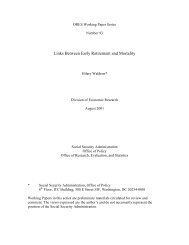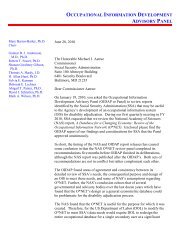Download entire publication - Social Security
Download entire publication - Social Security
Download entire publication - Social Security
Create successful ePaper yourself
Turn your PDF publications into a flip-book with our unique Google optimized e-Paper software.
<strong>Social</strong> <strong>Security</strong> Administration’s Master EarningsFile: Background InformationBy Anya Olsen and Russell Hudson*The <strong>Social</strong> <strong>Security</strong> Administration (SSA) receives reports of earnings for the U.S. working population each year.Earnings data are used to administer the <strong>Social</strong> <strong>Security</strong> programs and to conduct research on the populationsserved by those programs. The administrative needs of SSA and other agencies have changed over time and,as a result, there have been numerous changes to the main source of SSA’s earnings data, which is known asthe Master Earnings File (MEF). By documenting the history, content, limitations, complexities, and uses of theMEF (and data files derived from the MEF), this article serves as a resource for researchers who use earningsdata to study work patterns and their implications. It is also a resource for policymakers and administrators whomust understand the data used in administering current-law programs and the data available to inform potentialchanges to those programs.IntroductionEach year employers and the Internal Revenue Service(IRS) send information to the <strong>Social</strong> <strong>Security</strong> Administration(SSA) on the earnings of the U.S. workingpopulation. SSA uses this information to calculatebenefit amounts for all types of beneficiaries, includingretired workers, spouses, widow(er)s, children,and the disabled. SSA stores this earnings informationas the Master Earnings File (MEF) and because itcomprises IRS tax data, it is subject to IRS disclosurerules. 1 This file contains data derived from IRS FormW-2, quarterly earnings records, and annual incometax forms. These data include regular wages andsalaries, tips, self-employment income, and deferredcompensation (contributions or distributions). Inaddition to calculating <strong>Social</strong> <strong>Security</strong> benefits, MEFdata are used for policy analysis and research bothwithin and outside SSA. This article is primarily forresearchers interested in using data derived from theMEF to better understand the past and present U.S.working population. 2 It is also of use to policymakersand administrators who must understand the underlyingdata used in administering current-law programsand the data available to inform potential changes tothose programs. This article examines the history ofthe data, how the data are collected and entered intothe SSA computer systems, the information containedin the data, some limitations and complexities of usingthe data for research purposes, and how the agencyuses the data.History of the <strong>Social</strong> <strong>Security</strong> ProgramThe original <strong>Social</strong> <strong>Security</strong> Act, which was enactedin 1935, required that monthly benefits be paid toqualified individuals aged 65 or older based on theirwages from employment before age 65. 3 The lawtasked SSA’s predecessor, the <strong>Social</strong> <strong>Security</strong> Board(SSB), with obtaining earnings information in orderto calculate benefit amounts in retirement. In orderto assign earnings to a specific individual, the SSBestablished <strong>Social</strong> <strong>Security</strong> numbers (SSNs) to allowemployers to uniquely identify, and accurately report,earnings covered under the new program. This processbegan in November 1936 with the assistance of theSelected AbbreviationsAWICWHSEINESFFICAHIaverage wage indexContinuous Work History Sampleemployer identification numberEarnings Suspense FileFederal Income Contributions ActHospital Insurance* Anya Olsen is with the Office of Retirement Policy, Office of Retirement and Disability Policy (ORDP), <strong>Social</strong> <strong>Security</strong>Administration (SSA). Russell Hudson is with the Office of Research, Evaluation, and Statistics, ORDP, SSA.<strong>Social</strong> <strong>Security</strong> Bulletin • Vol. 69 • No. 3 • 2009 29








